Barcelona–El Prat Airport
| Barcelona–El Prat Airport Aeropuerto de Barcelona–El Prat Aeroport de Barcelona–El Prat | |||||||||||||||||||
|---|---|---|---|---|---|---|---|---|---|---|---|---|---|---|---|---|---|---|---|
.jpg) | |||||||||||||||||||
| IATA: BCN – ICAO: LEBL | |||||||||||||||||||
| Summary | |||||||||||||||||||
| Airport type | Public | ||||||||||||||||||
| Owner | ENAIRE | ||||||||||||||||||
| Serves | Barcelona, Spain | ||||||||||||||||||
| Location | El Prat de Llobregat | ||||||||||||||||||
| Hub for | |||||||||||||||||||
| Focus city for | |||||||||||||||||||
| Elevation AMSL | 14 ft / 4 m | ||||||||||||||||||
| Coordinates | 41°17′49″N 002°04′42″E / 41.29694°N 2.07833°ECoordinates: 41°17′49″N 002°04′42″E / 41.29694°N 2.07833°E | ||||||||||||||||||
| Website |
aena | ||||||||||||||||||
| Map | |||||||||||||||||||
 BCN Location within Spain | |||||||||||||||||||
| Runways | |||||||||||||||||||
| |||||||||||||||||||
| Statistics (2015) | |||||||||||||||||||
| |||||||||||||||||||
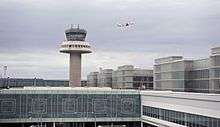
Barcelona–El Prat Airport[4][5] (IATA: BCN, ICAO: LEBL) (Catalan: Aeroport de Barcelona – el Prat, Spanish: Aeropuerto de Barcelona-El Prat), also known as Barcelona Airport, is an international airport located 12 km (7.5 mi) southwest[6] of the centre of Barcelona, Spain, lying in the municipalities of El Prat de Llobregat, Viladecans, and Sant Boi.
It is the main airport of Catalonia, the second largest in Spain behind Madrid Barajas Airport and one of the busiest in the world. In 2015 Barcelona Airport handled a record 39.7 million passengers, up 5.7% from 2014.[7][8] It is a main base for the main Spanish airlines like Vueling and a hub for Iberia or Air Europa, as well as the Irish low-cost giant Ryanair and the Irish carrier Norwegian Air International. The airport mainly serves domestic European destinations, also having flights to North America (United States of America and Canada), South America (Argentina, Brazil, Colombia and Peru), Middle East (Egypt, Israel, Jordan, United Arab Emirates, Qatar), Asia (China, Singapore and South Korea), and Africa (Senegal, Gambia, Tunisia, Algeria, Morocco, Ghana and Cape Verde).
The Barcelona–Madrid air shuttle service, known as the "Puente Aéreo" (in Spanish), or "Pont Aeri" (in Catalan) literally "Air Bridge", was the world's busiest route until 2008, with the highest number of flight operations (971 per week) in 2007.[9] The schedule has been reduced since February 2008, when a Madrid–Barcelona high-speed rail line was opened, covering the distance in 2 hours 30 minutes, and quickly became popular.[10]
History
Barcelona's first airfield, located at El Remolar, began operations in 1916. However, it did not have good expansion prospects, so a new airport at El Prat opened in 1918. The first plane was a Latécoère Salmson 300 which arrived from Toulouse with final destination Casablanca. The airport was used as headquarters of the Aeroclub of Catalonia and the base for the Spanish Navy's Zeppelin fleet. Scheduled commercial service began in 1927 with an Iberia service to Madrid Cuatro Vientos Airport. This was Iberia's first route. During the time of the Second Spanish Republic El Prat was one of the bases of LAPE (Líneas Aéreas Postales Españolas).[11]
In 1948, a runway was built (now called runway 07-25); in the same year the first overseas service was operated by Pan American World Airways to New York City, using a Lockheed Constellation. Between 1948 and 1952, a second runway was constructed (runway 16–34), perpendicular to the previous, also taxiways were constructed and a terminal to accommodate passengers. In 1963, the airport reached one million passengers a year. A new control tower was built in 1965. In 1968, a new terminal was opened, which still exists and is in use as what is now Terminal 2B.[12]
On 3 August 1970, Pan American World Airways inaugurated regular service between Barcelona, Lisbon and New York, operated by a Boeing 747. On 4 November of the same year, Iberia began the "Air-shuttle" service between Barcelona and Madrid–Barajas. A few years later, in 1976, a terminal was built specifically for Iberia's air-shuttle service and a terminal exclusively for cargo, an annexed mail service and an aircraft ramp for air cargo. In 1977, the airport handled over 5 million passengers annually.
From the late seventies to the early nineties, the airport was stalled in traffic and investments until the 1992 Summer Olympics held in Barcelona. El Prat underwent a major development consisting of the modernization and expansion of the existing terminal, which became known as Terminal B, and the construction of two further terminals flanking that, known as Terminals A and C respectively.[12] The development included jetways for direct access to the aircraft. This reform was designed by architect Ricardo Bofill Levi.
In 1992, a new control tower was inaugurated also designed by Ricardo Bofill Levi, but this was replaced by another much needed control tower in 2006.
The new Terminal 1 was inaugurated on 16 June 2009, covering 545,000 m2 (5,866,331 sq ft). 70% of today's flights operate from Terminal 1. The old Terminals A, B and C are now known as Terminals 2A, 2B and 2C.
Due to the strong drop in air traffic after 1999 and the crisis in the aviation sector in 2001 many charter operations from Girona and Reus were diverted to El Prat, which helped the airport to survive the crisis.
On 1 February 2014, Barcelona–El Prat was the first Spanish airport to receive a daily flight with the Airbus A380-800, on the Emirates route to Dubai International Airport. Emirates also offers a second daily flight, but with Boeing 777 aircraft.
Since June 2016 the second daily flight to Dubai is flown with another A380.
In September 2016, Norwegian Air Shuttle announced flights from Barcelona to Los Angeles, Oakland and Newark in June 2017, and Fort Lauderdale in August 2017.[13]
Operations
Most of the traffic at Barcelona Airport is domestic and European, in which Vueling has an operational base. Intercontinental connections have not generated a significant amount of passenger traffic during the last years. In the early twenty-first century the airport passenger carried numbers and the number of operations increased significantly.
Low-cost airline traffic grew significantly, especially after the creation of operating bases by Vueling and Clickair at the airport. Vueling and Clickair merged in July 2009, operating under the Vueling name. Other low-cost airlines operate from the airport, including Ryanair, EasyJet, Norwegian Air International, EasyJet Switzerland, Wizz Air and Transavia.com. A new base was established at the airport in September 2010.
The airport has 3 runways, two parallel, nominated 07L/25R and 07R/25L (the later opened in 2004), and a cross runway 02/20. There are two terminals: T2, which is the sum of the previous Terminals A, B and C, located on the north side of the airport and T1, on the west side, which opened on 16 June 2009. As of 2014 the two terminals had a combined total of 268 check-in counters and 64 boarding gates. Operations at the airport are restricted exclusively to Instrument flight rules (IFR) flights, except for sanitary, emergency and government VFR flights.
A plan for expansion (Plan Barcelona)[14] was completed in 2009, adding a third terminal building (also designed by Ricardo Bofill) and control tower. An additional runway (07R/25L) was also built. The airport became capable of handling 55 million passengers annually (up from 33 million in 2007). The airport expanded in area from 8.45 to 15.33 square kilometres (3.26 to 5.92 sq mi). Further expansion was planned to be finished by 2012, with a new satellite terminal to raise capacity to 70 million passengers annually, this is better explained in Terminal T1 section.
The airport is the subject of a political discussion over management and control between the Generalitat of Catalonia and the Spanish Government, which has involved AENA (airport manager) and various airlines, Iberia and Spanair mainly. Part of the controversy is about the benefits that the airport generates, which are used in maintenance and investments in other airports in the network of AENA and government investments in other economic areas.
Terminals
Terminal 1
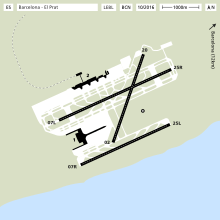

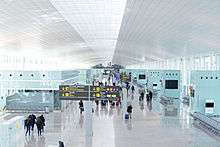
A new Terminal 1 designed by Ricardo Bofill was inaugurated on 16 June 2009. It is the fifth largest in the world, and has an area of 548,000 m2 (5,900,000 sq ft), an aircraft ramp of 600,000 m2 (6,500,000 sq ft), 13,000 new parking lots and 45 new fingers expandable to 60. This terminal is also capable to embrace large aircraft like the Airbus A380-800 or Boeing 747-8I.
The terminal handles both Schengen and non-Schengen flights. It is split into 5 Modules with Module A handling flights to Madrid, Module B handling Schengen flights, Module C handling Air Nostrum flights, Module D handling non-Schengen European flights and Module E handling non-Schengen non-European flights.
Its facilities include:
- 258 check-in counters
- 60 jetways (some are prepared for the A380, with double jetway)
- 15 baggage carousels (one of the new carousel is equivalent to 4 carousels in the old terminal) and
.jpg) Dawn at Barcelona El Prat Airport with Vueling plane
Dawn at Barcelona El Prat Airport with Vueling plane - 24,000 parking spaces, in addition to the 12,000 already in the terminal 2.
The forecast is that the airport will be able to handle 55 million passengers annually —as opposed to the 30 million people before its construction— and will reach 90 operations an hour.
The extension of the airport with a total investment of €5.1 billion in the future will include a new satellite terminal and refurbishment of existing terminals. The civil engineering phase of the South Terminal has been made possible by a budget of €1 billion.
It is also planned the construction of a satellite terminal —T1S or Terminal 1 Satèl·lit, in Catalan— considering that the airport is on the verge of collapse because terminals cannot handle all passengers because of space shortage. This terminal will be at 1,5 kilometres from the current T1 terminal, behind the 02-20, transversal, runway. With this action, the airport will be able to increase its passenger capacity to 70 million people annually.
Terminal 2
Terminal 2 is divided into three linked sections, known as Terminal 2A, 2B and 2C. Terminal 2B is the oldest part of the complex still in use, dating back to 1968. Terminals 2A and 2C were added in order to expand the airport capacity before the arrival of the 1992 Summer Olympics held in city.[12] This expansion was also designed by Ricardo Bofill Levi.
This terminal is most occupied by low-cost airlines, although there are some airlines which are not low-cost in this terminal.
Following the opening of Terminal 1 in 2009, Terminal 2 became almost empty until the airport authorities lowered landing fees to attract low-cost and regional carriers to fill the terminal. Whilst this has helped, the complex is nowhere near full capacity and Terminal 2A is currently unused. Terminal 2C is used only by EasyJet and EasyJet Switzerland flights, with flights to the UK using module M0, whilst flights to the rest of Europe use module M1. Terminal 2B is mostly used by Ryanair and others, like Transavia. And T2A is adapted for large airplanes, such as B777. The terminal is also split into Modules, where flights to schengen destinations use Module U and flights to non schengen destinations use Modules W and Y.
Airlines and destinations
Passenger
Cargo
Statistics
.jpg)
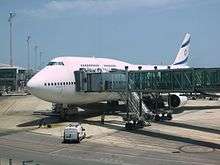
.jpg)
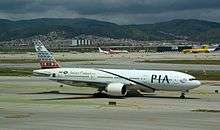
.jpg)
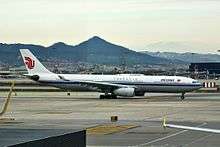
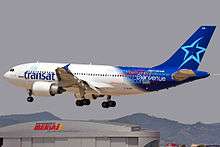
.jpg)
.jpg)
| Rank | Airline | Passengers | Services to |
|---|---|---|---|
| 1 | |
14,727,381 | Europe, Africa, Asia |
| 2 | |
5,698,773 | Europe, Africa |
| 3 | |
2,263,002 | Europe |
| 4 | |
1,360,959 | Germany (Munich and Frankfurt) |
| 5 | |
1,107,128 | Spain |
| 6 | |
1,087,492 | Spain |
| 7 | |
891,267 | Europe |
| 8 | |
868,952 | Great Britain (London) |
| 9 | |
738,483 | France (Paris) |
| 10 | |
593,964 | Switzerland (Geneva and Zürich) |
| 11 | |
575,868 | Germany |
| 12 | |
575,563 | Europe |
| 13 | |
574,451 | Switzerland |
| 14 | |
558,928 | The Netherlands (Amsterdam) |
| 15 | |
449,050 | The Netherlands |
| 16 | |
445,039 | Portugal |
| 17 | |
441,303 | United Arab Emirates (Dubai) |
| 18 | |
390,057 | Turkey |
| 19 | |
361,967 | Italy |
| 20 | |
300,871 | Russia (Moscow and Saint Petersburg) |
| 21 | |
297,757 | Qatar (Doha) |
| 22 | |
287,114 | United States of America |
| 23 | |
271,230 | Great Britain |
| 23 | |
248,517 | Belgium (Brussels) |
| 25 | |
226,165 | United States of America |
| Rank | Airport | Passengers | Carriers |
|---|---|---|---|
| 1 | 1.364.620 | British Airways, EasyJet, Monarch Airlines, Norwegian Air Shuttle, Vueling | |
| 2 | 1.241.129 | KLM, Transavia, Vueling | |
| 3 | 1.235.888 | Air France, EasyJet, Vueling | |
| 4 | 1.227.988 | Alitalia, Ryanair, Vueling | |
| 5 | 1.030.604 | Lufthansa, Vueling | |
| 6 | 982.125 | Transavia, Vueling | |
| 7 | 841.374 | Brussels Airlines, Ryanair, Vueling | |
| 8 | 766.960 | Lufthansa, Vueling | |
| 9 | 701.905 | British Airways, Vueling | |
| 10 | 660.880 | EasyJet, Vueling | |
| 11 | 622.038 | Swiss International Air Lines, Vueling | |
| 12 | 598.013 | EasyJet Switzerland, Swiss International Air Lines, Vueling| | |
| 13 | 593.219 | Portugalia, TAP Portugal, Vueling | |
| 14 | 507.870 | Ryanair | |
| 15 | 499.686 | Aer Lingus, Ryanair, Vueling |
Source: Aeroport de Barcelona, AENA. |
|
|
Ground transportation
Rail
Train
Terminal 2 has its own Rodalies Barcelona commuter train station on the line R2, which runs from the Maçanet-Massanes station every 30 minutes, with major stops at Barcelona Sants railway station and the fairly central Passeig de Gràcia railway station to provide transfer to the Barcelona Metro system, also in Clot station. Passengers for T1 must take a connecting bus from Terminal 2B to Terminal 1. As part of the major expansion above, a new shuttle train is going to be built from Terminal 1 to Barcelona Sants (connected with the high speed train, the AVE) and Passeig de Gràcia Stations is expected by April 2018.
Metro
Also this airport is linked to Barcelona by underground (metro) since February 12, 2016[35][36] by Line 9 of the Barcelona Metro with a station in each terminal, the Aeroport T1 station situated directly underneath the airport terminal T1 and the Aeroport T2 station close to the Aeroport rail station at the terminal T2. The line connects with several Barcelona Metro lines to the city center.
Road
The C-32B highway connects the airport to a main traffic interchange between Barcelona's Ronda de Dalt beltway and major motorways. There is provision for parking cars at the airport, with about 24,000 parking spaces.
Bus
The Transports Metropolitans de Barcelona (TMB) public bus line 46 runs from Plaça Espanya. The Aerobús offers direct transfers from T1 and T2 to the city center at Plaça Catalunya. Another company offers transfers from Barcelona Airport to nearest airports like Reus Airport or Girona–Costa Brava, provincial and national capitals and links with France or Andorra.
Taxi
Taxi ranks exist outside any of the main terminal exits Terminal 1 (T1) or Terminal 2.
Incidents and accidents
- On 21 October 1994 a Falcon 20 cargo aircraft made an emergency landing at the airport after suffering a malfunction in its landing gear; none of the three crewmembers were injured.
- On 19 February 1998, two people, the commander and the pilot died in an Ibertrans general aviation plane crash in the borough of Gavà shortly after taking off from El Prat.
- On 28 July 1998 a general aviation cargo plane carrying press from Mallorca crashed next to one of the fences surrounding the airport, killing two crew members and co-pilot.
- On 3 December 2010, during the Spanish air traffic controllers strike, Barcelona Airport remained inoperative when all Spanish air traffic controllers walked out in a coordinated wildcat strike. Following the walkout, the Spanish Government authorized the Spanish military to take over air traffic control operations.[37] On the morning of 4 December, the government declared a 'State of Alert', ordering the controllers back to work. Shortly after the measure was implemented, controllers started returning to work and the strike was called off.[38]
References
- ↑ "Ryanair apuesta por El Prat como 'hub' europeo | Cataluña | EL PAÍS". ccaa.elpais.com. Retrieved 11 June 2016.
- ↑ "Estadsticas – Aeropuertos Espaoles y Navegacin Area – aena-aeropuertos.es". Retrieved 1 June 2015.
- ↑ Spanish AIP (AENA) Archived 7 March 2012 at the Wayback Machine.
- ↑ "Orden FOM/1508/2011, de 18 de mayo, por la que se modifica la denominación oficial del Aeropuerto de Barcelona". BOE. (Spanish)
- ↑ "Barcelona–El Prat Airport – Aena Aeropuertos". Aena-aeropuertos.es. Retrieved 7 April 2013.
- ↑ EUROCONTROL basic. Eurocontrol.int. Retrieved on 4 October 2011.
- ↑ "Spain's airports enjoy record-breaking month of August". elpais.com. Retrieved 14 September 2015.
- ↑ "2015 saw the record figure of 39,711,276 passengers, 5.7% more than the previous year". aena.es. Retrieved 7 February 2016.
- ↑ "Air passenger transport in Europe in 2007" (PDF). eurostat.eu. Retrieved 14 September 2015.
- ↑ "Why the train in Spain is more popular than the plane". elpais.com. Retrieved 14 April 2014.
- ↑ aomd88. "Airline memorabilia: Alas de la República: CLASSA, LAPE (1934)". Retrieved 1 June 2015.
- 1 2 3 "History – Barcelona–El Prat Airport". aena. Retrieved 12 December 2014.
- 1 2 http://www.routesonline.com/news/38/airlineroute/268747/norwegian-launches-barcelona-us-service-from-june-2017/
- ↑ Barcelona / Plan Barcelona Archived 5 March 2007 at the Wayback Machine.. Aena.es. Retrieved on 4 October 2011.
- ↑ "American adds new International routes in S17". routesonline. Retrieved 11 September 2016.
- ↑ "Azores Airlines schedules new routes in S17". routesonline. Retrieved 13 October 2016.
- ↑ "AZORES AIRLINES INTRODUCES SERVICE TO BARCELONA FROM BOSTON". TravPR. Retrieved 6 November 2016.
- ↑ "Azores Airlines Introduces Service to Barcelona from Boston". Azores Adventures. Retrieved 6 November 2016.
- ↑ "Korean Air conectará Seúl y Barcelona con un vuelo directo en abril de 2017". Europa Press. Retrieved 23 November 2016. (spanish)
- ↑ http://aviacionchile.blogspot.pe/2016/07/latam-airlines-lanza-ruta-lima.html
- ↑ "Norwegian unirá los aeropuertos de Bilbao y Barcelona a partir del 8 de julio – ABC.es – Noticias Agencias". agencias.abc.es. Retrieved 11 June 2016.
- 1 2 "Newsdesk – Norwegian". media.norwegian.com. Retrieved 11 June 2016.
- ↑ http://www.ara.cat/economia/Norwegian-connectara-Barcelona-ciutats-EUA_0_1646235478.html
- ↑ PIA advertisement promoting Barcelona resumption
- ↑ "Primera Air Adds New Routes from Reykjavík in S15". Retrieved 1 June 2015.
- ↑ "Ryanair Flight Timetable". Ryanair.
- ↑ "S7 Airlines opens flights to Barcelona". S7.ru. S7 Airlines. Retrieved 23 May 2016.
- ↑ http://www.routesonline.com/news/38/airlineroute/270161/small-planet-expands-lublin-service-in-s17/
- ↑ "TAP Portugal S16 European Service Suspensions :: Routesonline". airlineroute.net. Retrieved 11 June 2016.
- ↑ "Transavia adds new routes from Munich in S17". routesonline. Retrieved 29 September 2016.
- ↑ "UNITED S16 International Operation Changes as of 10OCT15". Airlineroute.net. 10 October 2015. Retrieved 10 October 2015.
- ↑ http://www.teinteresa.es/dinero/OFRECERA-VUELOS-BARCELONA-CHISINAU-MOLDAVIA_0_1663034207.html
- ↑ "Wizz Air continues to expand in Macedonia – 3rd aircraft in Skopje, 1 new airport and 6 new routes". Wizz Air. Retrieved 22 January 2015.
- ↑ http://estadisticas.aena.es/csee/Satellite?c=Page&cid=1113582476702&pagename=Estadisticas%2FEstadisticas/[]
- ↑ "Cuenta atrás para la inauguración del metro al aeropuerto de El Prat" [Countdown to the opening the metro to the airport of El Prat]. La Vanguardia (Press release) (in Spanish). La Vanguardia. 14 January 2016. Retrieved 15 January 2016.
- ↑ "El metro hacia El Prat comenzará a funcionar el día 12 de febrero" [The metro to el Prat gonna starts on 12 february]. La Vanguardia (Press release) (in Spanish). La Vanguardia. 20 January 2016. Retrieved 20 January 2016.
- ↑ Batty, David (4 December 2010). "Spanish airports reopen after strike causes holiday chaos". guardian.co.uk. London. Retrieved 5 December 2010.
- ↑ Owen, Edward (4 December 2010). "Spanish air traffic controllers marched back to work as airports reopen". telegraph.co.uk. London. Retrieved 5 December 2010.
Further reading
- Zunino, Eric (November 2004) "Barcelona Airport", Airline World, pp. 40–43.
External links
![]() Media related to Barcelona Airport at Wikimedia Commons
Media related to Barcelona Airport at Wikimedia Commons
![]() Barcelona El Prat Airport travel guide from Wikivoyage
Barcelona El Prat Airport travel guide from Wikivoyage